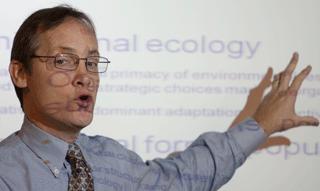Professors present franchise findings
Eastern professors David Boggs, Richard Flight and Marko Grünhagen in cooperation with professor Laura Lucia Palacios of the University of Zaragoza,presented their findings of “The Organizational Ecology of Franchises in the Automotive Services Sector” Monday.
Boggs, from the business department, first explained some terms that were going to be used in the presentation, along with their motivation for the study.
“We were all interested in related things,” Boggs said, explaining that each of them had their own interests incorporated into this study.
Grünhagen, from the business department, said that franchises were interesting businesses and the group wanted to study some businesses that evolve over time.
The study examines franchises that span 21 years. However, the study lacks a broad amount of economic data.
“Larger organizations tend to be more inert,” Boggs said, noting that they are more resistant to change.
The study has two research questions and four hypotheses. Each hypothesis deals with something separate compared to survival rate of the franchise. These topics include time, age, specialization, and number of units owned.
After the background and theory of the study was presented, Flight took the floor.
“My job is to introduce data,” Flight said. “21 years far exceeds other work in franchise ecology work.”
The team worked with 393 franchisors through the Franchise Annual. The team then analyzed the data by use of a Cox Model, which is a model used to explain the relationship between survival and other variables, such as the ones stated.
Flight also said the third variable in further detail, that specialization in a category of automotive services is key as well. For one service offered, the franchise is a narrow specialist. For two, three, and four or more services, the franchise is a dual specialist, generalist, or broad generalist respectively.
There were graphs that showed the number of each franchise in its specialization over the 21 years. The births and deaths of the firms and exit rate weren’t shown in these graphs.
Palacios then began to talk about the finer pieces of data, finding the variables together to find a correlation.
“The mean of values is really very low,” Palacios said, explaining that the closer the value is to ten, the more problems there are.
Palacios presented a graph illustrating the time and exit rate, the amount of franchises that ‘die.’
“Dual and narrow specialists are the ones with the least exit rate,” Palacios said.
Grünhagen elaborated that the higher percent of franchises has a constant, low exit rate.
“You better franchise at a high percentage (approximately 80 percent) to keep your survival rate up,” Grünhagen said.
The team continued with the discussion, elaborating on the research limitations, and concluded with the future research directions they have planned.
Jacob Swanson can be reached at 581-7942 or
Professors present franchise findings

David Boggs, assistant professor of management, gives the definition of organizational ecology during a research presentation in Lumpkin Hall Monday. Richard Flight, assistant professor, Marko Grünhagen, Lumpkin distinguished professor, and school of





































































